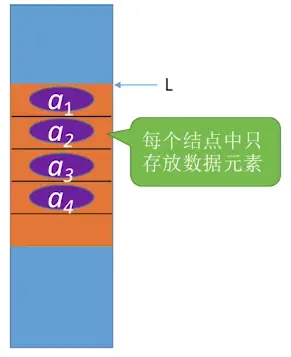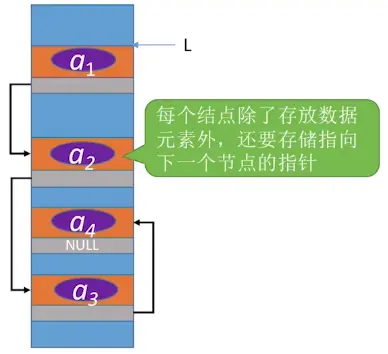什么是单链表
单链表是链表的其中一种基本结构。它是构成单链表的基本结点结构。在结点中数据域用来存储数据元素,指针域用于指向下一个具有相同结构的结点。 因为只有一个指针结点,称为单链表。
顺序表与单链表的区别
顺序表
(顺序存储)
优点:可随机存取,存储密度高 缺点:要求大片连续空间,改变容量不方便
单链表
(链式存储)
优点:不要求大片连续空间,改变容量方便 缺点:不可随机存取,要耗费一定空间存放指针(地址)
单链表结构
public class SinglyLinkedList <T> {
/**
* 头结点
*/
private Node head;
/**
* 链表长度
*/
private int size;
/**
* 结点
*/
class Node {
/**
* 结点数据
*/
private T t;
/**
* 下一个结点
*/
private Node next;
Node(T t, Node next) {
this.t = t;
this.next = next;
}
public Node(T t) {
this(t, null);
}
@Override
public String toString() {
return "Node{" + t + '}';
}
}
}
单链表基本操作
插入
/**
* 在指定下标处插入一个结点
* @param t
* @param index
* @return
*/
public boolean insert(T t, int index) {
if (index < 0 || index > size) {
throw new IllegalArgumentException("非法下标参数");
}
Node node = new Node(t);
// 链表头部插入结点
if (index == 0) {
node.next = this.head;
this.head = node;
this.size++;
return true;
}
// 找到要插入结点的前一个结点
Node preNode = getNode(index - 1);
// 前一个结点的下一个结点地址赋给当前结点的 next
node.next = preNode.next;
// 当前结点的地址赋给前一个结点的 next
preNode.next = node;
this.size++;
return true;
}
这里的插入是一个后插操作,既在某个结点之后插入一个结点,因为结点中存有下一个结点的地址,所以其后面的结点都很好寻找和操作了。 对应的还有前插操作,既在某个结点之前插入一个结点,这要求得拿到前一个结点,才能改变前结点的 next 指向。 要拿到前一个结点,可以从头结点开始,依次寻找,有了头结点就等于有了整个单链表。 如果没有头结点,就无法拿到前一个结点。此时只能对当前结点使用后插操作,在交换两个结点当中的数据,变相地实现了前插操作。
删除
/**
* 根据下标删除结点
*
* @param index
* @return
*/
public Node remove(int index) {
if (index < 0 || index > size) {
throw new IllegalArgumentException("非法下标参数");
}
Node removeNode = null;
// 删除头结点
if (index == 0) {
removeNode = this.head;
// 把头结点的下一结点作为头节点
this.head = head.next;
this.size--;
return removeNode;
}
// 找到删除结点的前一结点
Node preNode = getNode(index - 1);
// 把要删除的结点保存和返回
removeNode = preNode.next;
// 把前一结点的下下个结点地址赋值给前一结点的 next
preNode.next = preNode.next.next;
this.size--;
return removeNode;
}
/**
* 根据数据删除结点
*
* @param t
* @return
*/
public Node remove(T t) {
// 链表或元素为空 直接返回
if (size == 0 || null == t) {
return null;
}
Node removeNode = null;
for (int i = 0; i < size; i++) {
Node node = getNode(i);
if (t == node.t) {
removeNode = remove(i);
break;
}
}
return removeNode;
}
查找
/**
* 根据下标获取一个结点
*
* @param index
* @return
*/
public Node getNode(int index) {
if (index < 0 || index > size) {
throw new IllegalArgumentException("非法下标参数");
}
Node curNode = this.head;
// 下标为 0 直接返回头结点
if (index == 0) {
return curNode;
}
for (int i = 0; i < index; i++) {
curNode = curNode.next;
}
return curNode;
}
/**
* 根据元素值返回对应下标
*
* @param t
* @return
*/
public Node getNode(T t) {
// 从头结点开始
Node curNode = this.head;
// 当前结点不为空且结点数据不等于传入元素
while (null != curNode && curNode.t != t) {
// 当前结点后移
curNode = curNode.next;
}
return curNode;
}
完整代码
/**
* @description: 自定义单链表
* @author: opoa
* @create: 2021-02-28 20:21
**/
public class SinglyLinkedList <T> {
/**
* 头结点
*/
private Node head;
/**
* 链表元素个数
*/
private int size;
/**
* 结点
*/
class Node {
/**
* 结点数据
*/
private T t;
/**
* 下一个结点
*/
private Node next;
Node(T t, Node next) {
this.t = t;
this.next = next;
}
public Node(T t) {
this(t, null);
}
@Override
public String toString() {
return "Node{" + t + '}';
}
}
public SinglyLinkedList() {
this.head = null;
this.size = 0;
}
/**
* 根据下标获取一个结点
*
* @param index
* @return
*/
public Node getNode(int index) {
if (index < 0 || index > size) {
throw new IllegalArgumentException("非法下标参数");
}
Node curNode = this.head;
// 下标为 0 直接返回头结点
if (index == 0) {
return curNode;
}
for (int i = 0; i < index; i++) {
curNode = curNode.next;
}
return curNode;
}
/**
* 根据元素值返回对应下标
*
* @param t
* @return
*/
public Node getNode(T t) {
// 从头结点开始
Node curNode = this.head;
// 当前结点不为空且结点数据不等于传入元素
while (null != curNode && curNode.t != t) {
// 当前结点后移
curNode = curNode.next;
}
return curNode;
}
/**
* 在指定下标处插入一个结点
*
* @param t
* @param index
* @return
*/
public boolean insert(T t, int index) {
if (index < 0 || index > size) {
throw new IllegalArgumentException("非法下标参数");
}
Node node = new Node(t);
// 链表头部插入结点
if (index == 0) {
node.next = this.head;
this.head = node;
this.size++;
return true;
}
// 找到要插入结点的前一个结点
Node preNode = getNode(index - 1);
// 前一个结点的下一个结点地址赋给当前结点的 next
node.next = preNode.next;
// 当前结点的地址赋给前一个结点的 next
preNode.next = node;
this.size++;
return true;
}
/**
* 使用头插法插入一个元素
*
* @param t
* @return
*/
public boolean insertFirst(T t) {
return insert(t, 0);
}
/**
* 使用尾插法插入一个元素
*
* @param t
* @return
*/
public boolean insertLast(T t) {
return insert(t, size);
}
/**
* 根据下标删除结点
*
* @param index
* @return
*/
public Node remove(int index) {
if (index < 0 || index > size) {
throw new IllegalArgumentException("非法下标参数");
}
Node removeNode = null;
// 删除头结点
if (index == 0) {
removeNode = this.head;
// 把头结点的下一结点作为头节点
this.head = head.next;
this.size--;
return removeNode;
}
// 找到删除结点的前一结点
Node preNode = getNode(index - 1);
// 把要删除的结点保存和返回
removeNode = preNode.next;
// 把前一结点的下下个结点地址赋值给前一结点的 next
preNode.next = preNode.next.next;
this.size--;
return removeNode;
}
/**
* 根据数据删除结点
*
* @param t
* @return
*/
public Node remove(T t) {
// 链表或元素为空 直接返回
if (size == 0 || null == t) {
return null;
}
Node removeNode = null;
for (int i = 0; i < size; i++) {
Node node = getNode(i);
if (t == node.t) {
removeNode = remove(i);
break;
}
}
return removeNode;
}
/**
* 返回当前链表长度
*
* @return
*/
public int length() {
return this.size;
}
/**
* 打印输出单链表
*
* @return
*/
@Override
public String toString() {
if (size == 0) {
return null;
}
Node curNode = this.head;
StringBuilder sb = new StringBuilder();
while (null != curNode) {
sb.append(curNode.t.toString())
.append(" -> ");
curNode = curNode.next;
}
sb.append("null");
return sb.toString();
}
}
参考资料
2020 王道考研 数据结构【单链表的定义】
2020 王道考研 数据结构【单链表的插入删除】
2020 王道考研 数据结构【单链表的查找】
Java 基础 – 单链表的实现
![Featured image of post [Java] 单链表](https://cdn.jsdelivr.net/gh/oopooa/cdn/cover/rem-horn-dark.webp)

